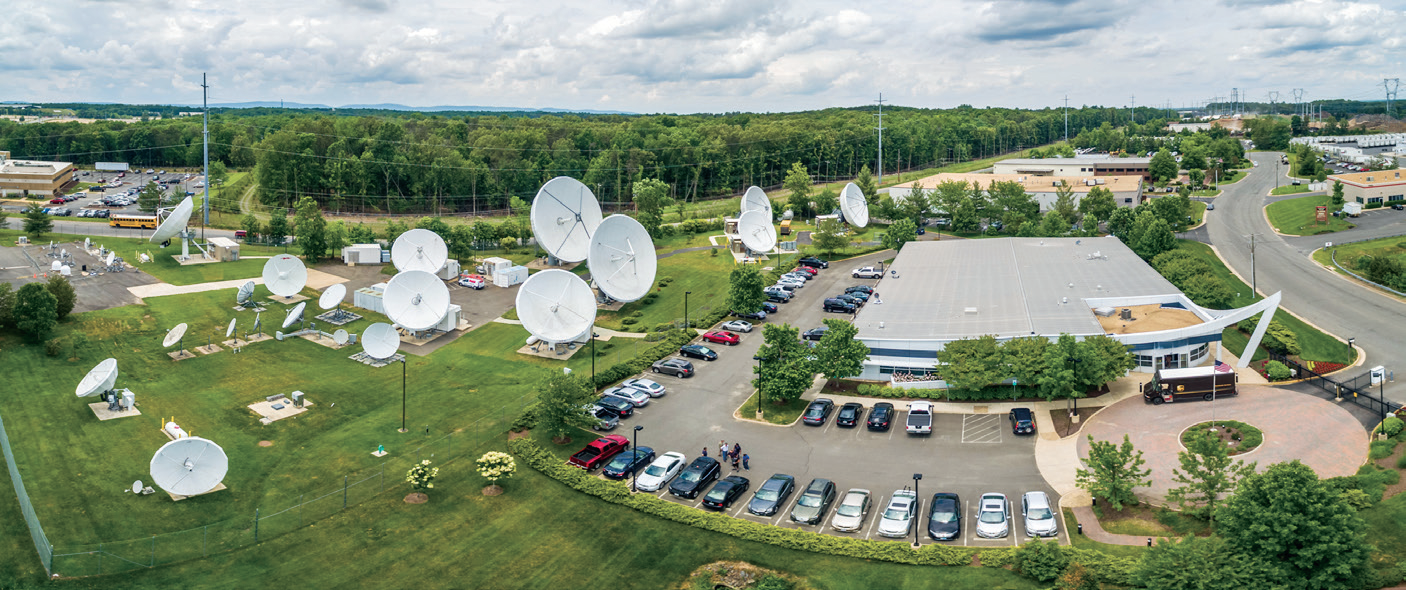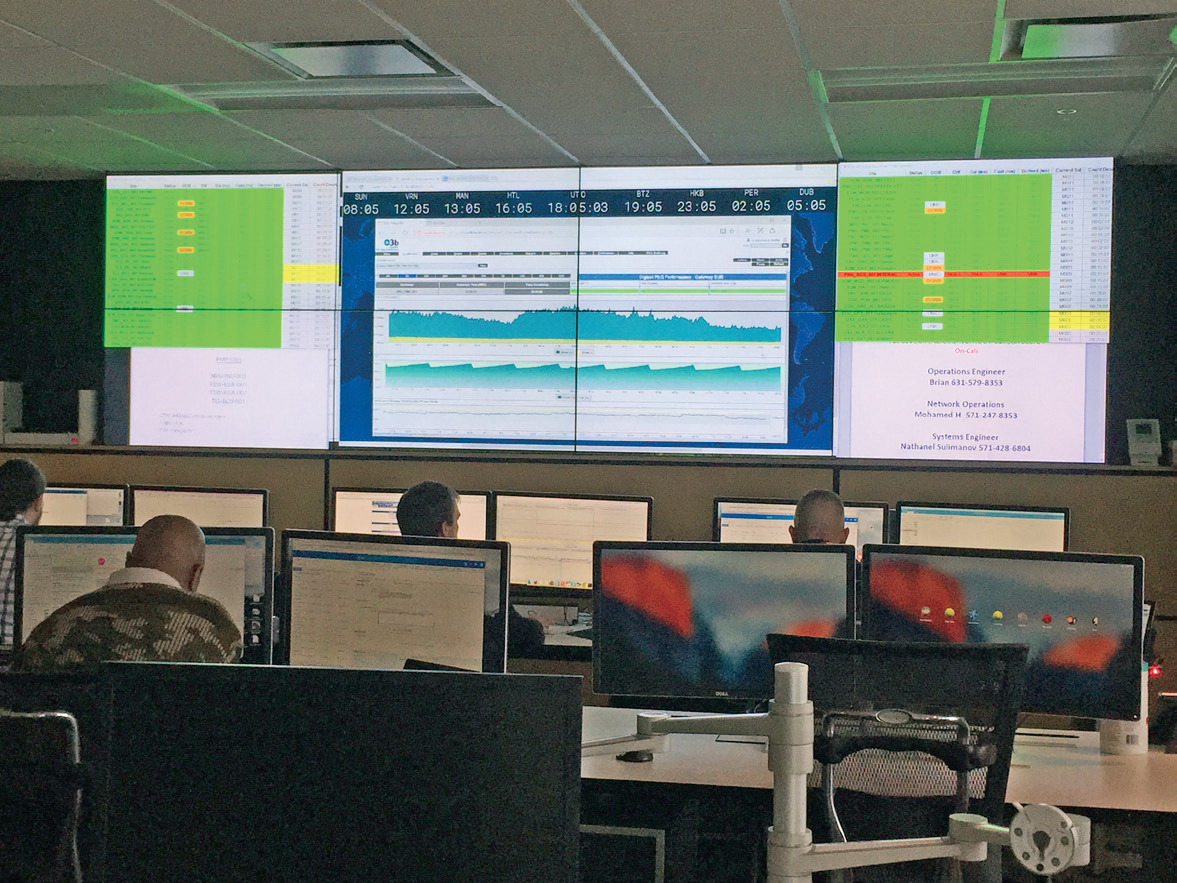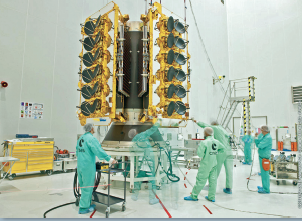Back in 1995, Newsweek published an article on “Why the Internet will fail.”—I’d like to share an excerpt from that article with you:

SES Government Solutions MediaPort in Bristow, Virginia, the location of ongoing O3b demos.
“Visionaries see a future of telecommuting workers, interactive libraries and multimedia classrooms. They speak of electronic town meetings and virtual communities. Commerce and business will shift from offices and malls to networks and modems. And the freedom of digital networks will make government more democratic. Baloney.
“…The truth is no online database will replace your daily newspaper, no CD-ROM can take the place of a competent teacher and no computer network will change the way government works.”
History shows that this 1995 assessment was short-sighted. In fact, in just over 20 years, technological advances are so commonplace that we often take them for granted. We now seamlessly operate in an environment in which networks actively change the way government works. The current age, with information accessible anywhere at any time, brings with it some truly game-changing capabilities—once unthinkable—that are redefining government operations.

New O3b Network Operations Center in Bristow, Virginia.
We flourish in an environment the author thought would be “baloney”—an interconnected digital realm that enables government operations. With its ability to extend those networks to areas once thought untouchable, O3b represents another leap forward that few thought possible just a few years ago.
O3b is a Medium Earth Orbit (MEO) constellation in Ka-band that provides high throughput and low latency capability. Even in austere environments that make fiber-optic infrastructure physically or fiscally challenging, O3b capabilities represent connectivity options that
are revolutionary.
Government users serve in some of the world’s most hostile environments where fiber and other infrastructure is not available. However, these users still need high speed capabilities necessary to execute their mission.
O3b’s fiber-like, easily deployable system is available and ready to be used today. The following are some of the scenarios where O3b’s high throughput and low latency can play a significant role in day-to-day operations.
Scenario #1: Army Information Backhaul From The Tactical Edge
As a direct provider of O3b capacity, SES Government Solutions (SES GS) reduces risk for the warfighter today. The O3b system can deliver that mission-critical information in real time. SES GS worked with industry partners to create a video dissemination platform that broadcasts multiple High Definition (HD), full-motion videos simultaneously through a “Youtube”-like interface. U.S. Government attendees had a chance to exercise this platform during the SES GS/O3b U.S. Government demonstration at MacDill Air Force Base in October of 2014. The demo featured six videos with no delay, pixelation or data lost.

Site of SES GS / O3b demo at MacDill Air Force Base in Tampa, Florida, during October 2014.
The Army’s expeditionary mission relies heavily on field sensors producing large data files, HD video streams and information loaded to and from ‘the cloud.’ These videos could be coming from unmanned aerial systems, sensors or mobile devices used by Army soldiers.
During the MacDill demo the SES GS team conducted a complete 3.8 GB file transfer in about three and a half minutes over O3b’s network. Meanwhile, the government’s current VSAT (Very Small Aperture Terminal) solution projected an estimated download time of over eight hours for the same file.
The point was clear: an O3b-enabled solution provides decision-quality information to the warfighter much faster than traditional VSAT solutions.
Scenario #2: Secure, Connected and High-Speed Wifi for the Navy
The second scenario addresses the need for high-speed Internet on Navy carriers, command ships and large deck ships. An O3b installation on these ships provides a dramatic increase in connectivity for each sailor.
Consider a scenario where a sailor is injured and needs to be transported back to land in order to implement a proper diagnosis and treatment. The ship’s doctor could communicate with shore-based hospital efforts that could recommend life-saving procedures in real-time.

O3b satellite build being completed
Using Ultra HD video conferencing riding on O3b, the sailor could simply under-go treatment on the spot, potentially saving the Navy thousands of dollars in air transportation costs and saving the sailor’s life. This particular telemedicine scenario actually took place during O3b’s satellite demonstration with the U.S. Navy’s 7th Fleet during a Limited Objective Experiment (LOE) last year.
For Navy on-board WiFi, the O3b solution can provide throughput to more than 6,000 devices per ship, with 300 times the capacity of a typical cruise ship. The result would be video teleconferencing, 24/7 video surveillance as well as morale boosting applications such as video games, streaming video and Skype all without any delay, pixelation or buffering. This technology is currently being implemented by Royal Caribbean’s Quantum of the Seas cruise ship customers today.
Scenario #3: Uninterrupted Live Streaming For Rescue Missions
The final example is a hot spot scenario, like an embassy in a hostile environment where fiber has been cut by adversaries, or is unreliable,
unavailable or just has not been installed. It could take months to restore severed fiber connections and perhaps years to install new fiber.
For any national security threat at an embassy, such as a hostage crisis, the U.S. Government needs to identify and act on the threat as soon as possible. They also need to provide situational awareness for any effective planned relief effort and key decision makers overseas from the Pentagon to the White House.
An O3b solution would allow reliable, responsive access to mobile phones, tablets and security cameras to ensure a seamless, continuous live stream of information during a time-sensitive and life-threatening scenario. When identifying a target—be it through high resolution video, photo or map—you can assure that the decision will be accurate. By implementing and using O3b, the decision will be real time supported by crystal clear imagery products.
Proven Technology Ready To Be Deployed Today
O3b capitalizes on modems, advanced satellites and efficient links to enable operations. The key however is the quick availability of this technology. An SES GS-engineered O3b solution can be up and running within 60 days. Upon receipt of all equipment, the ‘box to bird’ set up time for the two antenna O3b system can be as quick as 45 minutes. That equates to an HTS-enabled, fiber-like network anywhere in the world.
While some companies are talking about connecting the unconnected, SES and O3b are doing such today. In fact, O3b satellites are currently transmitting to over 40 customers worldwide.
SES GS has made the investment in purchasing, testing and demonstrating the O3b system and can provide outstanding throughput for time-sensitive missions. With O3b, SES GS once again breaks all barriers with heart-racing performance that will revolutionize modern warfare.
In 1995, conventional wisdom was short-sighted. By 2005 a giant leap was underway. Today we stand on the edge of the next generation of communications technology for the warfighter. SES GS is the catalyst to make this vision a reality today.
ses-gs.com/

Mike joined SES Government Solutions in the fall of 2015. His responsibilities include business development and sales in support of strategic initiatives for SES Government Solutions. His responsibility is to grow the O3b presence in the satellite marketplace.
Mike has held key positions at several leading companies in the Satellite community including GM and SATCOM Director at CVG (Kratos), Section Manager within the wireless group at Northrop Grumman TASC, and Business Development and Sales Manager at Micro-Ant. He has more than 28 years of engineering, design and sales experience in the RF, antenna, and satellite communications marketplace.

